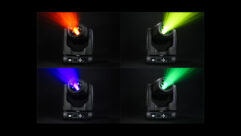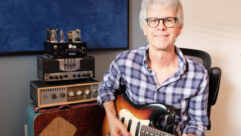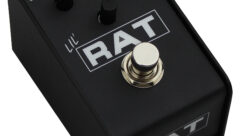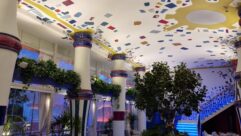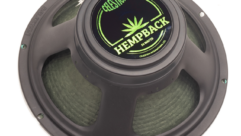Blues Power
Oct 1, 2003 12:00 PM,
Daniel Keller
In a little more than a decade, the House of Blues has evolved from a few hip clubs to a concert and media powerhouse, a transformation made possible in part by embracing technology, not simply following it.
In fall 1992, Isaac Tigrett and friends were ready to realize a new vision. Two years earlier, the millionaire philanthropist and cofounder of the Hard Rock Café had sold his interest in that company and gone off to India to consult with his spiritual advisor, Sri Satya Sai Baba, on what his next path might be. Interestingly, though Tigrett credits Sai Baba with convincing him to divest the Hard Rock, it was the guru who later helped inspire his move back to the restaurant business.
The House of Blues vision began with a historical old house in Cambridge, Massachusetts’s Harvard Square. But it was clear even at the outset that it would evolve into something much greater in scope than a handful of nightclubs. Tigrett, after all, was a consummate master at building brand recognition and not known for doing things on a small scale. The new venture would go well beyond simply live music and cuisine. It would educate and communicate, thus fostering an atmosphere of diversity and tolerance.
Tigrett and close friend Dan Aykroyd pulled together a partnership with a number of high-profile investors, among them Jim Belushi, River Phoenix, Paul Shaffer, members of Aerosmith, and Harvard University. On Thanksgiving Day in 1992, after feeding a group of homeless people, the original House of Blues opened its doors to the public. It was followed in 1994 with venues in Los Angeles and New Orleans; a Chicago location debuted in 1996, with Orlando, Florida, and Myrtle Beach, South Carolina, clubs opening a year later. Two more clubs have since been built in Las Vegas and Anaheim, California, bringing the total to eight.
Tigrett parted with the company in 1997, remaining as chairman emeritus, and was replaced by Greg Trojan, former CEO of California Pizza Kitchen. But the organization has continued to keep his vision in sight, even as it has grown perhaps beyond even Tigrett’s original expectations. Today House of Blues Entertainment has become the second-largest music promoter in the United States. With the acquisition of more than 20 amphitheaters in the United States and Canada, House of Blues venues now welcome between 10 million and 20 million visitors annually. The company also enjoys a strong history as a content producer for radio, television, and Internet broadcasting media. Also under the House of Blues umbrella is the Loews Hotel in Chicago, a syndicated radio hour hosted by Dan Aykroyd as Elwood Blues, and the International House of Blues Foundation, a nonprofit organization dedicated to bringing music and the arts to city schools and communities, as well as raising mainstream awareness of African-American contributions to America.
GET IN THE HOUSE
Although each of the eight House of Blues restaurants is unique in its own right, the atmosphere and decor follow a common thread through all the venues. It’s a surrounding that is part museum, part opera house, and part roadhouse, with an eclecticism that is reflected in the art, the menus, and the music. The restaurants are at once both striking and welcoming. But to dine at a House of Blues and miss the show is to miss the point, for these are environments tailor-made for music.
IT’S THE MUSIC, STUPID
At its most basic, the attraction of House of Blues has always been about the music. The clubs have built a buzz by traditionally supporting a more eclectic mix of musical genres and demographics, with a focus on both national/international and local music beyond the commercial mainstream. “We spend a lot of time reaching out to our local markets and giving back to the communities,” says Aron Levine, vice president of production and distribution. “Our talent buyers are all amazing people. They’re totally tuned in to their local scenes, as well as to the bigger picture. Part of our philosophy is to find baby bands and help them progress from playing to a few hundred to selling out our clubs and eventually our arenas.”
Indeed, House of Blues has attracted a following among not only music fans but among musicians and their management, who see it as an artist-friendly organization. With venues ranging from small clubs to amphitheaters, House of Blues can offer multiple levels of exposure for touring acts. In 2002 the Who and Pearl Jam included the Chicago House of Blues in tours that were otherwise arena-based.
MAKE YOURSELF AT HOME
Part of the reason the clubs are so well respected within the music industry is their attention to quality and detail, particularly in the venues’ production systems. “One of the things we try and do in the club environment is to consistently provide touring bands with the level of production they’re accustomed to when they play larger theaters or arenas,” Levine says. “They know that when they play a House of Blues, they can leave the semis outside and just come in and have a great time, without the work or cost of loading in and out for a one-off date.”
Maintaining the A/V technology in the clubs is a constantly evolving process. “We really endeavor to provide the artists with what they need and try to make sure we are as current as possible,” Levine says. “Production value is as important or more so than it has been in years, with the consumer becoming more educated about what to expect for the price of a ticket.”
Feedback from artists, crew, and fans is critical. “It’s amazing how strong word of mouth on tour is — it can either support or hurt you,” Levine says. “When acts and crews leave our venues and go the next one, we want to be setting the bar by their experience with us, both technically and in terms of overall experience. A good portion of that is feedback they get from fans and friends: how the day went; how the equipment worked, or didn’t; and how the crew worked. We really want to provide the best and most current tools possible, fiscally and technically, for our crew to succeed. Nothing is worse than having to spend the first 20 minutes of every day defending your rig or venue.”
Of course, the first and most lasting impressions are usually made not by the equipment but by the people. “Over the years, we have put together a great group of production managers and staff,” Levine says. “Since each venue is its own business and operates as such, financial decisions made by the venue must be supported by the business they are doing. Therefore all of our service and maintenance is done by the same folks who help design and install the systems.”
A sense of pride of ownership is nurtured when people are involved with the installation of equipment, Levine says. Accordingly, as equipment needs replacing or breaks, it’s easier to fix.
“When we hire stagehands and loaders, we’re always asking ourselves, ‘Can this person make the move to LD, FOH engineer, or production coordinator?’” Levine says. “We really try to provide a learning and training facility for our incoming and rookie staff, in hopes that they can one day be the production manager of a House of Blues.”
Currently, the company has two production managers who were part-time loaders; after years of hard work and dedication, they climbed the ladder and now run the departments for their venues. “One of my proudest moments is when one of our local production people gets snatched up by a tour coming through — it happens all the time, and it’s something we are very proud of,” Levine says. “We try to create a work environment and teach the work ethics that make for good team players and exceptional employees. When one of them is taken out on tour, it’s just proof that we are finding the right people and hopefully offering good training to help further their careers.”
FRIENDS HELPING FRIENDS
An important aspect in keeping the venues technologically competitive and up to date has been the forging of strategic partnerships with select companies. “Over the years, we’ve partnered with a few companies that we feel develop quality products and have significant market share and brand recognition,” says Levine. “We’re very protective of the House of Blues brand and very selective in our partnerships. Conversely, it’s a great opportunity for these manufacturers to showcase their equipment in front of millions of visitors and a wide variety of artists and production people.”
One manufacturer that has worked closely with House of Blues for many years is Chicago-based Shure, which provides microphones and wireless equipment for all the clubs. “When House of Blues approached us to sponsor their venues as part of an endorsement deal, we knew that we were going to be part of a world-class entertainment venue,” says Tom Krajecki, Shure’s entertainment manager. “By standardizing their equipment and taking such care in the production of their shows, they consistently put on incredible performances in each of their venues from night to night. This helps them look good and helps us look good.”
Another sponsor that has contributed significantly to House of Blues’ sonics is Telex/EV, which has placed its X-Array and Xi-series systems in five of the clubs, as well as Midas Heritage and XL-series mixers and EV amplification. (The Orlando and Myrtle Beach locations feature EAW KF-series systems and Crest consoles, and the original Cambridge club sports an Allen and Heath console and a combination of Meyer and EAW speakers, with Crown amplification.)
“We really look for relationships that are long-term and mutually beneficial,” Levine says. “We kind of all get together and discuss the programming for the venue and what will work best for each architectural challenge.”
It’s also an ideal setting to work together with manufacturers in developing their products and identifying new opportunities. Levine reports that U.K.-based lighting console manufacturer Avolites has implemented a number of new features based on feedback from House of Blues. “When we first started using the console six years ago, it was not all that well known, and our lighting directors had to do most of the programming,” Levine says. “These days I would say that 80 percent of the incoming lighting directors are not only totally familiar with the programming language and methods but love working the console.”
The company has developed a mutually supportive relationship with BSS, as well, which has been instrumental in the development of House of Blues’ distributed A/V systems. “We are now able to create multiple, fully independent zones and environments for audio and video and easily switch feeds in any zones via local touch screens,” Levine says. “We know we’re only scratching the surface of what it can do, but it’s so easy to work with. It’s bulletproof and offers just what we need. They were also very open to hearing our feedback, and when challenged to produce a video matrix that would follow the audio sources, they came through. It really was one of our weak links, until we found them and were able to start a relationship.”
This system allows House of Blues to do multiple events in every room and not stress the technology out — from meetings and videoconferencing to presentations, sporting events, small bands, or DJs. “Denny McLane at BSS has really helped to figure out what equipment works best, and he has assisted with the programming to maximize the usage,” Levine says.
On the lighting side, the technology may be moving even faster. “John Wiseman and Grif Palmer at High End Systems have been great in keeping us ahead of the curve and really showcasing the newest in intelligent lighting to the acts that play the House of Blues venues,” Levine says. “With a large arsenal of equipment and specialists, they provide us with new directions and keep us in touch with the latest and greatest in tools and technology.” Additional sponsors include Drum Workshop, Sabian, and Ultimate Support.
Even before getting to the club, the production manager can log on to a Web site and access technical information for each individual venue, from FOH and monitor system specs, lighting, and power details, to mic lists, back-line equipment, and even stage and dressing room dimensions. “We’ve got eight clubs now and plans for several new openings over the next few years,” Levine says. “Ultimately, we’d like to be able to offer bands an House of Blues tour circuit of 15 or 20 venues.”
THE MEDIA IS THE MESSAGE
One of the more visible aspects of House of Blues’ early business model was the new media division, which heavily embraced then-nascent Internet streaming technologies. House of Blues was one of the first music venues to broadcast over the Internet.
Each of the existing House of Blues clubs was equipped with high-bandwidth fiber-optic lines and set up for multiple camera shoots and digital-audio capabilities, and word began to spread about this emerging technology within the high-tech community.
By early 1997, five of the venues were set up for live high-bandwidth digital-audio feeds. Fans from anywhere could attend an average of six to eight Webcast concerts every week or browse an amazing treasury of high-quality archived concert footage at www.hob.com.
The site helped establish House of Blues as a high-profile, innovative content provider and media entity. “We went out with a game plan and a business plan,” Levine says. “[The Web site] became a model for digital downloads and pay-per-view, as well as creating live content for DVD and home video. It wasn’t just about the Web — we were partnering with larger distribution vehicles like NBC, VH-1, MTV and DirecTV.”
CHANGING HORSES MIDSTREAM
Much of this would change with the recent Supreme Court rulings in the RIAA case involving online content. Like many other Webcasters, www.hob.com complied and took most of its live content offline. “Things didn’t pan out the way people originally envisioned, so we refocused the Web site and online group toward internal promotion and venue support,” Levine says. “It was just one of many facets of our company, so it was just a matter of redirecting our resources.”
And redirect it has. As the lines of global media distribution blur between network, cable, satellite, and Internet, House of Blues is positioned as one of the top players in this viable market. “Our clubs are still set up for multiple camera shoots and digital audio, and we still produce TV and DVD projects,” Levine says. “We’ve been out there long enough to make a name for ourselves as producers of high-end live music content, and our clubs are known for their great sound, so artists and labels frequently hire us to capture a show or event.”
In fact, the venues are ideal showcases for digital video technology. “We use a closed-circuit system throughout each of the clubs to help provide lines of sight at the bars and the back of the room,” Levine says. “In some of our venues, we’ve added large-format, roll-down screens and LCD projectors in the balconies to help provide better viewing opportunities. For these rooms, we have a very simple one- or two-camera setup that allows us to provide a wide shot and, if the artist will allow it, a close-up. For some high-profile shows, we hire a small video crew to tie into our system and do a multicamera shoot.”
The company is just starting to get into LCD panels and has sidestepped the plasma phase. “We are going to start incorporating this technology into our VIP areas and Foundation Rooms,” Levine says. “We are also starting to talk with various companies about creating a low-cost solution to multicamera closed-circuit imaging to really enhance the experience at the back of the house, bars, or VIP rooms. There is also is a need for this technology for special-event groups that want to broadcast award shows, speeches, and meetings onstage into various rooms of the venue.”
In addition to video capture and replay, much of company’s appeal comes from its expertise in streaming technology. Levine cites a recent project for Fox as an example. “The network was doing its up-fronts, where they showcase next season’s shows for potential advertisers,” Levine says. “We linked our L.A. and Chicago House of Blues venues together with a club in Detroit and a hotel in New York, all via fiber, and did a four-way simulcast that included a duet with last year’s American Idol winners, one in Los Angeles and one in New York, streamed live to all four venues. Fox didn’t have to bring in its own trucks; it was able to use our existing fiber lines and infrastructure.” Likewise with their annual productions of several outdoor events for L.A. radio station KROQ. “We’re essentially the back-end production — there’s no House of Blues branding. They shoot the shows close in for the crowd, and we take that feed and mix in sponsorship info and credits and Webcast it through KROQ’s site at various bit rates in Windows Media and Real Audio formats.”
Other recent live recordings at House of Blues have included Norah Jones, Floetry, Bernie Williams, and Better than Ezra. “We’ve partnered with a post-production group in Culver City, California, Dynamik Media, founded by the founders of Sublife.com. We have full online and offline production capabilities, which is being supported by Digidesign and Avid. House of Blues has always been really artist and management supportive, and those relationships are important to us. They know we can support them and work well with everyone — artists, management, labels, third-party producer — to create really effective promotional campaigns.”
Beyond simply creating the content, House of Blues is also in a position to contribute its own promotional muscle. “We have an in-house TV network, HOB-TV, in all our branded venues and a few amphitheaters, and we broadcast to select hotels in some markets, too, like our Chicago hotel,” Levine says. “This is a Mac-based system that, coupled with software developed by Gefen Systems, creates a TV program that runs on all House of Blues screens prior to and after shows, in all rooms.”
The chain uses this vehicle to advertise upcoming shows, special, events, and opportunities for consumers, including marketing and sponsorship platforms. The systems permit streaming live video, concert info, promotions for sponsors, and archived footage of artists. The systems are networked over an internal network, and the machines are programmed, updated, and operated from the House of Blues hub in Los Angeles.
EVOLUTION IS CONSTANT
Despite the organization’s growth, House of Blues has managed to stay pretty true to its founding philosophies. The Foundation’s involvement in urban arts and music education is stronger than ever, and the venues continue to be a vibrant part of their local music communities.
Plans are in the works for new House of Blues venues, with cities such as Paris, Tokyo, London, and New York named as potential locations. The company is always exploring new possibilities and technologies. “We really consider ourselves an ever-evolving, progressive technology content distributor,” Levine says. “Our technical capabilities are still strong, and though we’ve had to change with the market shift, we’re always in development with new shows and concepts. Our overall philosophy on digital media is consistent with what it’s always been. Ultimately, we want to produce and promote events, big and small, for global media distribution, whether via satellite, cable, network, or the Web. As technologies evolve and we open new venues, we’re looking forward to seeing what the future holds.”
Daniel Kellerhas no intention of running for governor of California.
Get the Blues Online
For more information about how the House of Blues incorporates the latest in A/V technology at its clubs, go to www.svconline.com. Check out a host of Web exclusives about this growing chain of venues.


